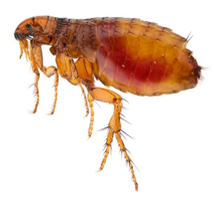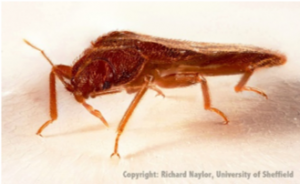Pets and Bed Bugs – How to Keep Them Safe
A common question asked is, “Will bed bugs affect my pets?”
Pets are part of the family, and we’re always concerned about the well-being of pets during a bed bug crisis.
All situations are different and with bed bugs, it all depends.
When bed bugs are everywhere, chances of your family pet(s) getting bitten will increase.
Sometimes, hiring a professional isn’t possible, so severe infestations may build up.
So, it’s important to avoid the build-up of bed bugs.
Should You Be Concerned?
Even though bed bugs are a human bug, they will feed on any warm-blooded mammal when given the chance.
This includes dogs, cats, mice, birds, hamsters, and ferrets.
Or any other fur pet you may own that share the same characteristics that every mammal does.
But there are things to take into consideration.
Carbon dioxide that we breathe and warmth attracts bedbugs.
Learn more here[1]
Their only survival is blood.
Humans are easy targets because we are not covered in fur.
And common places where we find bed bugs is in our beds, easy chairs or couches.
Bed bugs will stay close to where they are getting their blood meal.
In serious infestations, they spread to other parts of the home.
A dog or cats’ bedding or blanket can’t house a bed bug or two.
Let’s Look at The Anatomy of a Bed Bug
If you examine the feet of a bed bug, on the end of each leg you will see two claws.
They use these to crawl to their victim.
Once they find their victim, they navigate the exposed skin areas to find a capillary to feed from.
Unless you are bald, you won’t find bites in or on your head, beard or any area that you may have thick hair growth.
They can’t crawl through hair and here’s why:
Their bodies are so flat [without a blood meal], that they can fit into cracks as thin as a piece of paper.
Flat like a disk, they have a hard time navigating through hair.
 Fleas[2], [which feed on and bite our pets], are vertical.
Fleas[2], [which feed on and bite our pets], are vertical.
Their vertical body shape allows them to slide between hair to reach the skin for a blood meal.
And their strong claws help them stay lodged in the hair.
If you have a serious infestation, when hungry, bed bugs may feed on your pets.
You may find bites on areas of the pet’s body that has the least amount of hair like ears and belly.
Again, depending upon the circumstances and extent of your infestation.
What If You Find A Bed Bugs on Your Pet?
Bed bugs don’t live on humans or pets.
If you find a bed bug on your pet it’s because it’s foraging for a meal or your pets’ bedding may house bed bugs.
Because you find one doesn’t mean they are “infested” with them like with fleas.
You can use a fine-tooth comb or brush and remove it.
There is no need to reach for a poisonous shampoo that may be much more harmful to your pet than a bed bug would be.
Precautions for Pet Bedding
During an infestation, inspect your pets’ bedding for signs of bed bugs.
Wash and dry the bedding often to keep it fresh and clean and clear of any such bed bugs.
Itchy Pets?
If there isn’t an alternative reason like food allergies, dry skin or flea bites, it may have been from a bed bug.
Don’t spray your pet down with insecticides, it’s not necessary, it may harm them nor does it work as a preventative.
Bed bugs bites can be pretty itchy.
And you don’t want your pet to be uncomfortable or cause a secondary infection from scratching.
If your pet is scratching, speak to your veterinarian.
Your vet may suggest the use of Benadryl or another product.
These will ease the itching and comfort your pet until the bite heals.
Always consult your professional veterinarian before you use any over-the-counter product.
Best Bed Bug Solution
Considering the time and cost of bed bugs, it’s wise to take precautions to avoid infestations.
And, especially learn how to detect bed bugs early.
But, if you should be dealing with a bed bug “situation”, we are here to help you get rid of them.
How?
All living insects, bacteria and viruses have a “Thermal Death Point”. [3]
Bed bugs and their eggs cannot live when exposed to elevated temperatures of 125 degrees.
Heat proves to be the best elimination technique for bed bugs and their eggs.
We specialize in bed bugs, and have both professional services and bed bug heater rentals if you want to do it yourself.
You can always count on Nashville Bedbugsto bring you great bed bug information and solutions!
[1]https://ibbra.org/bed-bugs-knowledgebase/
[2]https://en.wikipedia.org/wiki/Flea
[3]https://medical-dictionary.thefreedictionary.com/thermal+death+point


